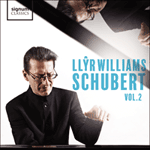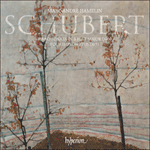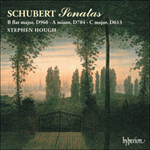
Welcome to Hyperion Records, an independent British classical label devoted to presenting high-quality recordings of music of all styles and from all periods from the twelfth century to the twenty-first.
Hyperion offers both CDs, and downloads in a number of formats. The site is also available in several languages.
Please use the dropdown buttons to set your preferred options, or use the checkbox to accept the defaults.

The B flat sonata has acquired an aura of otherworldliness, as if Schubert were already communicating from beyond the grave. Yet we should be wary of reading it, or its two companions, as a protracted farewell. While Schubert realized that he was unlikely to make old bones, he had no inkling until his final illness that the autumn of 1828 would be his last. There is pathos, and a sense of evanescence, in the sonata but also (in the last two movements) exuberance, humour and a sheer zest for life.
The soft, deep trill on a dissonant G flat that intrudes on the sublime calm of the opening immediately illustrates a crucial difference between Beethoven’s and Schubert’s methods. Where Beethoven would have integrated the trill into the music’s argument, for Schubert it remains something ‘other’: remote, mysterious, an extreme contrast in sonority and register with everything that surrounds it. Only once, in the transition from exposition to development (heard only if the exposition is repeated, as in Marc-André Hamelin’s performance), does the trill erupt in fortissimo violence. But while the trill’s function remains essentially colouristic, like a distant timpani roll, the note G flat does prefigure an important tonal area in the movement: in the leisurely expansion of the main theme that follows the opening statement, and in the F sharp minor theme (F sharp being the enharmonic equivalent of G flat) in the piano’s tenor register that opens the second group.
Like the exposition, the development unfolds with infinite spaciousness. After building to a fortissimo climax—a hint, perhaps, of human anguish in this quietest and most inward of sonata movements—the music hovers hauntingly around D minor, with the opening bars of the main theme, in hushed preparation for the recapitulation. In this context the theme’s momentary appearance, ppp, in a chromatically shadowed B flat has an effect of luminous strangeness, as if the home key is distantly glimpsed through a gauze.
The mood of ethereal tranquillity deepens in the andante sostenuto, a nocturnal barcarolle in C sharp minor. As so often in Schubert’s piano music, the texture of the opening theme suggests string chamber music, above all the famous adagio of the string quintet: it is not hard to imagine a second violin and viola intoning the floating, almost becalmed melody against delicate pizzicatos from the other strings. In the hymnic central episode, set in the warmly contrasting key of A major, the rich texture evokes a trio or quartet of cellos. When the main theme returns it acquires a new murmuring accompanying figure deep in the bass. Before the coda finally resolves into C sharp major, Schubert conjures another of his unearthly visions with a deflection to the fathomlessly remote key of C major.
With its nonchalant shifts of register and delicious harmonic sideslips, the scherzo forms a mercurial interlude between the timeless contemplation of the andante and the more corporeal world of the finale. The minor-keyed trio, with its lumpen off-beat bass, sounds like a skewed, cussed Ländler.
Launched by a held octave G, the rondo finale begins with a Hungarian-tinged dance tune which feints at C minor before resolving into the ‘proper’ key of B flat. In another of Schubert’s gloriously leisurely structures there are several memorable themes, including a gliding cantabile over a rippling accompaniment, and a mock-heroic F minor outburst that dissolves into a skittish dance. Only at the very end is the main theme’s ambiguity resolved, with the octave G slipping to G flat and then to F, before the brilliant, quasi-orchestral send-off. Though he could hardly have known that this would be virtually his last instrumental work, Schubert, like Beethoven in the Op 130 finale, bows out with mingled robustness, lyrical tenderness, and wry, quizzical grace.
from notes by Richard Wigmore © 2018
La sonate en si bémol majeur se situe dans une toute autre atmosphère que l’attachement aux biens de ce monde, comme si Schubert communiquait déjà d’au-delà de sa tombe. Mais il faut rester circonspect et ne pas la considérer, elle ou ses deux pendants, comme un adieu prolongé. Si Schubert avait compris qu’il ne ferait sans doute pas de vieux os, il ne se doutait pas, avant sa dernière maladie, que l’automne 1828 serait le dernier. Il y a dans cette sonate un pathos et une impression d’évanescence, mais aussi (dans les deux derniers mouvements) de l’exubérance, de l’humour et une pure joie de vivre.
Le trille doux et profond sur un sol bémol dissonant qui s’immisce dans le calme sublime du début illustre d’emblée une différence essentielle entre les méthodes de Beethoven et celles de Schubert. Là où Beethoven aurait intégré le trille dans l’argument de la musique, pour Schubert il reste quelque chose d’«autre»: lointain, mystérieux, un contraste extrême de sonorité et de registre par rapport à tout ce qui l’entoure. Une seule fois, dans la transition de l’exposition au développement (seulement si l’exposition fait l’objet d’une reprise, comme dans l’exécution de Marc-André Hamelin), le trille jaillit avec une violence fortissimo. Mais si la fonction du trille reste essentiellement liée à la couleur, comme un roulement de timbales lointain, la note sol bémol préfigure bien une zone tonale importante dans ce mouvement: dans le développement tranquille du thème principal qui suit l’exposition initiale, et dans le thème en fa dièse mineur (fa dièse étant l’équivalent enharmonique de sol bémol) dans le registre ténor du piano qui ouvre le second groupe.
Comme l’exposition, le développement prend des dimensions infinies. Après être montée à un sommet fortissimo—peut-être une pointe d’angoisse humaine dans ce mouvement de sonate très calme et intime—, la musique plane de manière envoûtante autour de ré mineur, avec les premières mesures du thème principal, une préparation feutrée de la réexposition. Dans ce contexte, l’apparition momentanée du thème, ppp, dans un si bémol assombri chromatiquement, a un effet d’étrangeté lumineuse, comme si la tonalité d’origine était entrevue à travers une gaze.
L’atmosphère de tranquillité éthérée augmente dans l’andante sostenuto, une barcarolle nocturne en ut dièse mineur. Comme si souvent dans la musique pour piano de Schubert, la texture du thème initial fait penser à la musique de chambre pour instruments à cordes, en particulier le célèbre adagio du quintette à cordes: il n’est pas difficile d’imaginer un second violon et un alto entonnant la mélodie flottante, faisant presque du sur-place sur les délicats pizzicatos des autres cordes. Dans l’épisode central, une sorte d’hymne en la majeur qui présente un chaud contraste, les riches textures évoquent un trio ou un quatuor de violoncelles. Lorsque le thème principal revient, c’est sur une nouvelle figure d’accompagnement qui murmure profondément dans le grave. Avant que la coda finisse par se résoudre en ut dièse majeur, Schubert fait apparaître comme par magie une autre de ses visions mystérieuses avec un détournement de la tonalité infiniment éloignée d’ut majeur.
Avec ses changements de registre nonchalants et ses délicieux glissements harmoniques latéraux, le scherzo forme un interlude vif entre la contemplation intemporelle de l’andante et l’univers plus matériel du finale. Le trio en tonalité mineur, avec sa basse informe sur les temps faibles, ressemble à un Ländler déformé et entêté.
Lancé par un sol tenu à l’octave, le rondo final commence par une mélodie de danse à la hongroise qui feinte en ut mineur avant de se résoudre dans la tonalité «appropriée» de si bémol majeur. Dans cette autre structure au calme merveilleux de Schubert, il y a plusieurs thèmes mémorables, notamment un cantabile qui plane sur un accompagnement ondulant, et un grand éclat burlesque en fa mineur qui se dissout dans une danse capricieuse. L’ambiguïté du thème principal ne se résout qu’à la fin, le sol à l’octave glissant à sol bémol puis à fa, avant les brillants adieux quasi orchestraux. Même s’il pouvait difficilement savoir que ce serait presque sa dernière œuvre instrumentale, Schubert, comme Beethoven dans le finale de l’op.130, tira sa révérence avec un mélange de fermeté, de tendresse lyrique et une grâce interrogatrice empreinte d’ironie.
extrait des notes rédigées par Richard Wigmore © 2018
Français: Marie-Stella Pâris
Die B-Dur-Sonate umgibt heute eine Aura des Jenseitigen—als spreche in ihr Schubert schon aus dem Grabe zu uns. Doch sollten wir uns hüten, sie oder ihre beiden Schwesterwerke als ausgedehnten Abschied vom Leben zu hören. Zwar mochte Schubert klar gewesen sein, dass er nicht alt werden würde; doch dass der Herbst 1828 sein letzter sein sollte, konnte er nicht wissen. Ja, es tönen ein gewisses Pathos und Gesten der Vergänglichkeit aus der Sonate, doch ebenso hört man hier Überschwang, Humor und Vitalität.
Der leise, tiefe Triller auf dem dissonierenden Ges, der in die erhabene Ruhe des Beginns einbricht, steht für einen wesentlichen Unterschied zwischen dem Komponieren Beethovens und Schuberts. Während Beethoven den Triller in den diskursiven Verlauf der Musik integriert hätte, bleibt er bei Schubert etwas emphatisch anderes: fremd, geheimnisvoll, ein äußerster Kontrast in Klang und Lage gegenüber der gesamten Umgebung. Ein einziges Mal nur, in der Überleitung von der Exposition zur Durchführung (die man nur dann hört, wenn die Exposition wiederholt wird wie hier von Marc-André Hamelin), bricht der Triller in ein gewaltsames Fortissimo aus. Doch während der Triller hier, wie ein ferner Paukenwirbel, vor allem färbende Funktion hat, nimmt der Ton Ges einen wichtigen Tonartbereich des Satzes voraus: in der zwanglosen Entfaltung des Hauptthemas, die dem Anfang folgt, und im fis-Moll-Thema (Fis als enharmonische Verwechslung von Ges) in der Tenorlage, das die zweite Themengruppe eröffnet.
Wie die Exposition entfaltet sich die Durchführung in einen scheinbar unendlichen Raum hinein. Nachdem die Musik sich zu einem Fortissimo-Höhepunkt gesteigert hat—vielleicht ein Bild menschlicher Seelennot in diesem sonst einzigartig stillen, nach innen gewandten Sonatensatz—, umkreist die Musik zögernd d-Moll, wie in beklommener Erwartung der Reprise. Wenn dann das Thema ppp in chromatisch verschattetem B-Dur einsetzt, nimmt es ein fremdartige Färbung an, so als nähme man die Haupttonart wie durch einen Schleier wahr.
Die ätherisch-gelassene Stimmung vertieft sich im Andante sostenuto, einer nachtdunklen Barcarolle in cis-Moll. Wie so oft in Schuberts Klaviermusik klingt das Anfangsthema nach Streicherkammermusik, allen voran nach dem berühmten Adagio des Streichquintetts: Es fällt nicht schwer, sich die schwebende, beruhigte Melodie von der zweiten Violine und der Bratsche gespielt vorzustellen, über einer zarten pizzicato-Begleitung der übrigen Streicher. Im hymnischen Mittelabschnitt, kontrastierend in warmem A-Dur gehalten, lässt der dichte Satz an ein Trio oder Quartett aus Violoncelli denken. Wenn das Hauptthema zurückkehrt, erscheint eine neue, aus der Tiefe raunende Begleitfigur. Bevor die Coda in Cis-Dur schließt, beschwört Schubert eine weitere unirdische Vision im unendlich weit entfernten C-Dur herauf.
Das Scherzo bildet mit seinen zwanglosen Registerwechseln und köstlichen harmonischen Rückungen ein quicklebendiges Zwischenspiel zwischen der zeitvergessenen Versunkenheit des Andante und der geradezu körperlichen Diesseitigkeit des Finales. Das Moll-Trio klingt mit seinem klobigen, gegen das Metrum humpelnden Bass wie ein schräger, trotziger Ländler.
Nach dem Startsignal des oktavierten G beginnt das Rondo-Finale mit einem ungarisch gefärbten Tanzthema, das nach c-Moll zu streben scheint, sich dann aber zum „richtigen“ B-Dur hin auflöst. Abermals glückt Schubert hier ein herrlich ungezwungener Formablauf mit mehreren einprägsamen Themen, darunter ein gleitendes Cantabile über murmelnder Begleitung sowie ein f-Moll-Ausbruch, der sich heroisch gibt, um sich sogleich in ein ausgelassenes Tänzchen zu verwandeln. Erst ganz am Schluss wird die Janusköpfigkeit des Hauptthemas aufgelöst, indem die G-Oktave nach Ges und schließlich nach F absinkt; dann folgt der brillante, gleichsam orchestrale Schluss. Schubert konnte, wie gesagt, nicht ahnen, dass dies sein letztes Instrumentalwerk sein würde; doch wie Beethoven mit dem Finale des Opus 130 verabschiedet er sich mit einer etwas schadhaften Kraftgeste, mit lyrischer Zartheit und eigenwilliger Anmut.
aus dem Begleittext von Richard Wigmore © 2018
Deutsch: Friedrich Sprondel
 Schubert: A Schubert Journey Schubert: A Schubert JourneyWelsh pianist Llŷr Williams is widely admired for his profound musical intelligence and the expressive and communicative nature of his interpretations. These recordings were made in conjunction with a critically lauded recital series at the Royal ...» More |
 Schubert: Piano Music, Vol. 2 Schubert: Piano Music, Vol. 2Schubert's final piano sonata—D960 in B flat major—and the seminal 'Wanderer' fantasy as captured live during Llŷr Williams' electrifying concert series at the Royal Welsh College of Music and Drama in 2018/9.» More |
 Schubert: Piano Sonata & Impromptus Schubert: Piano Sonata & ImpromptusThe heavenly lengths of Schubert’s last piano sonata and second set of impromptus: Marc-André Hamelin captures the other-worldliness of these sublime, quintessentially ‘late’ works as do few other pianists.» More |
 Schubert: Piano Sonatas D613, 784 & 960 Schubert: Piano Sonatas D613, 784 & 960‘His moving performance of the B flat Sonata, marked throughout by refined, discerning pianism and an uncommonly subtle ear for texture … Hough s ... ‘The recording is of exemplary clarity, warmth and truthfulness’ (Gramophone)» More |

